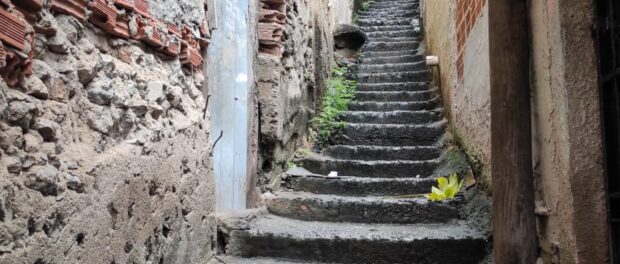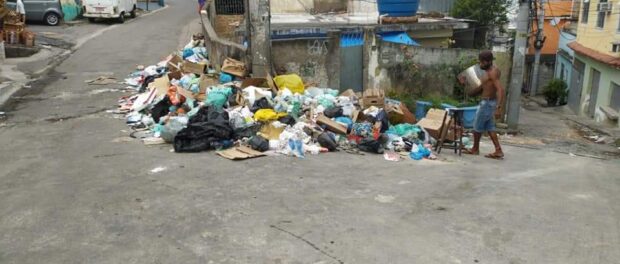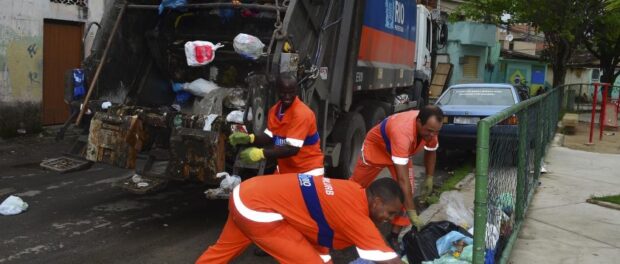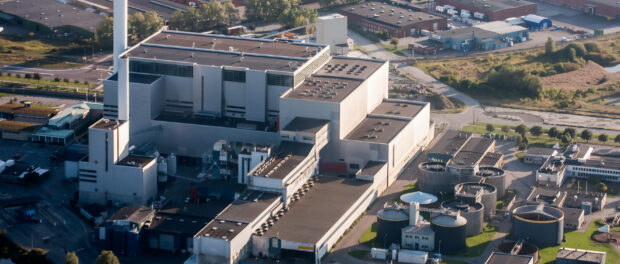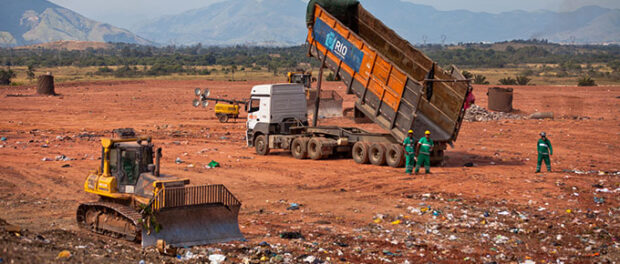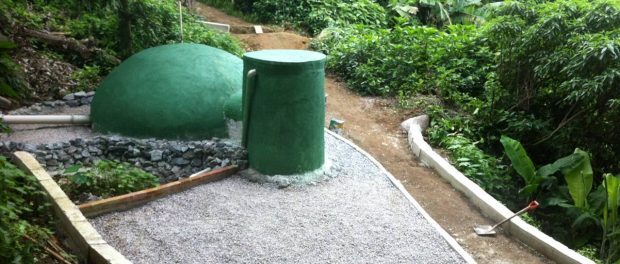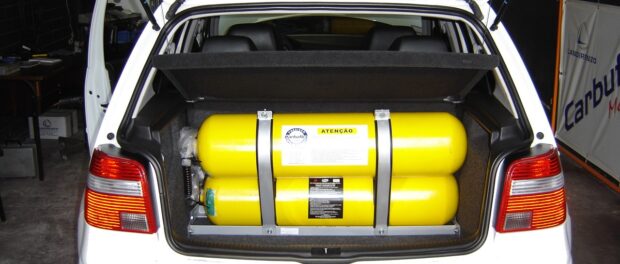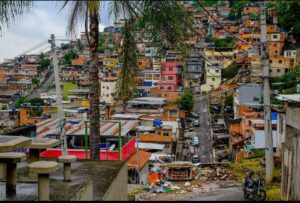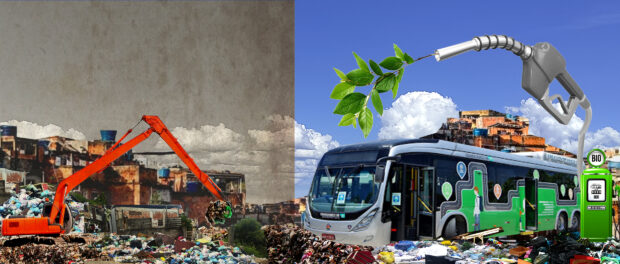
This article is part of a series about energy justice and efficiency in Rio’s favelas.
Every day, tons of garbage are collected by vehicles from waste collection utility COMLURB in Rio de Janeiro’s favelas. According to data shared by Renato Santos, president of the Residents’ Association of Itararé, a favela within Complexo do Alemão, from October to November 2020, a total 2,369.63 tons of solid waste were collected from the group of favelas—1,180.30 tons in October and 1,189,25 tons in November. Improper disposal of waste has been a historic problem in Rio’s favelas and urban peripheries. This is generally seen by residents as a problem with service provision or the absence of collection. However, garbage can also be seen as a possibility for generating income for favelas, as well as a way to improve socio-environmental, energy, and basic sanitation issues in their alleys and narrow streets.
Given how difficult it is to access up-to-date and reliable public data about favelas, we contacted COMLURB requesting information about the quantity of waste collected in Complexo do Alemão in recent months, while also looking for other sources of information. Days later, we received an email from an employee saying: “We don’t sort the waste by community. You must have seen some kind of estimate. Can you send it to us so we can see what it is?”
With this reality as a starting point—the State’s strategy of using lack of data concerning favelas as [justification for a lack of] public policy—we aimed to estimate, based on available public data and data from civil society institutions, an interval, in tons per day, that represented an approximation of the quantity of waste produced in Complexo do Alemão. To do this, the first challenge was determining the number of residents in Complexo do Alemão. Once we had this number, we were able to make an estimate of the production—and collection—of waste in these territories. We arrived, mathematically, at a plausible scenario for the volume of waste produced daily in this group of favelas: multiplying the number of residents by the volume, in kilos, of waste produced on average, per Brazilian, every day.
Population estimates for Complexo do Alemão vary greatly, a result of the State’s statistical negligence regarding favelas. According to the 2010 census, there are 70,000 residents; local associations, on the other hand, estimate the population at 120,000; and according to other sources, like WikiFavelas, there could be as many as 180,000. Bearing this in mind, and taking into consideration that, according to the ABRELPE (2020), a Brazilian generates, on average, 1.04kg of waste a day, we estimate that between 80 and 206 tons of waste are produced in Complexo do Alemão on a daily basis.
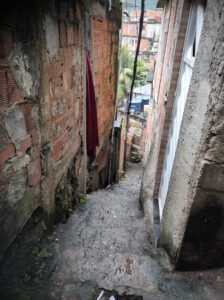 The logistics currently used for the collection of all this waste is insufficient. As a resident, I have observed for years that collection only happens at points spread out along the main roads. Also, though collection occurs every day of the week, during working hours, since Complexo do Alemão has narrow streets, with long, steep alleyways with staircases, the collection is always inadequate, sometimes very distant from residents’ houses, and always obstructing traffic.
The logistics currently used for the collection of all this waste is insufficient. As a resident, I have observed for years that collection only happens at points spread out along the main roads. Also, though collection occurs every day of the week, during working hours, since Complexo do Alemão has narrow streets, with long, steep alleyways with staircases, the collection is always inadequate, sometimes very distant from residents’ houses, and always obstructing traffic.
Moreover, pickup is done during what is rush hour for residents, so COMLURB’s big trucks always have to do the removal quickly in order not to interrupt traffic on the main roads, which are often narrow. This leads to a rushed collection: trucks do not have enough time to take away all the garbage from the favela’s collection points. There are always pieces of garbage, slurry and leftovers strewn around, which lead to the habit of discarding trash in points of the favela and the constant presence of disease vectors, animals, and insects. Therefore, a lot of waste ends up being left behind, a completely unsanitary situation for residents, even when the community has a regular collection service.
So, there you have it: all these people generating lots of waste every day, and this waste should either leave the favela or be transformed into energy, jobs, and income, ideally locally. Starting with reusing and recycling, and reducing consumption, there are various possible sustainable destinations for this waste, some more and some less prevalent. One suggestion that I believe can be transformational, both environmentally and economically, as well as being energy-efficient and promoting fair distributional justice for this and for other favelas, is to transform waste into biomethane gas—a clean and renewable energy strategy.
The generation and production of biomethane gas from waste is already a reality in many European countries, such as Norway and Sweden. The use of sanitary landfills for organic waste has been banned in Norway since 2009. Following a similar path to Norway, Sweden is the world leader in energy recovery from waste, with less than 1% of its trash going into sanitary landfills. Through various processes that start, first, with intense reduction, recycling, reuse and anaerobic digestion, the Swedish also make use of limited incineration in waste-to-energy (WTE) plants.
Notably, Sweden has one of the highest recycling rates in the world—99% of what is thrown away is recycled. We should, first of all, avoid consumption and the generation of waste; reuse products and materials as much as possible in their original form; recycle materials, transforming them into new products; recover energy from materials; and, as a last resort, dispose of waste in landfills. The success of the Swedish recycling system comes from the population’s environmental awareness. Moreover, there is a law that makes it the responsibility of the producer or manufacturer to guarantee that whoever manufactures, transfers or imports a certain type of product must make sure that this product—after it is discarded—is collected, transported, recycled or incinerated in the right way. By guaranteeing waste disposal that is acceptable to people’s health and to the environment, expensive Swedish sanitary landfills are only used as a last resort.
In this way, practically all types of waste are reused. Garden waste, for instance, is collected and treated through anaerobic digestion to produce biogas, although part of it is composted. In 2017, the total energy recovered from Swedish food waste was 975,680MWh, of which 856,170MWh were for biogas suitable for vehicles. This substituted about 83.3 million cubic meters of natural gas that, when burned, are equivalent to approximately 42,000 tons of carbon dioxide.
Furthermore, approximately 2.2 million tons of Swedish domestic waste are incinerated in WTEs per year. When the system is working correctly, before leaving the chimneys, the gases produced during burning pass through a group of filters, which capture the majority of the most toxic pollutants and prevent them from being emitted into the atmosphere.
Taking into account that, in terms of energy, 3 tons of waste burned equals 1 ton of oil, we can say that there is a lot of energy in trash. WTEs work far below their capacity, and thus, the energy recapture service is offered by Sweden to other countries like Norway, the United Kingdom, Ireland, and Italy. We can say that Sweden imports tons of waste from other European countries per year, offering them an increasingly sought-after service: a controlled destination, with a smaller environmental impact than sanitary landfills. The increasing demand is due to the fact that open dumps are completely out of the question, and sanitary landfills are increasingly regulated and expensive in Sweden’s client countries. Waste is a commodity with ever-growing prices.
In Brazil, there is still little debate about turning waste into energy, though this could help solve a big public health and basic sanitation problem. Since not all the trash is collected in favelas, this attracts an enormous number of vectors that are harmful to our health. Rats are the main example, not to mention flies and cockroaches. It could also bring an energy solution to our territories, that suffer daily from inequalities and lack of access to energy justice.
The transformation of waste into biomethane gas is already happening in some places in Brazil. Here in Rio de Janeiro, waste is being turned into energy in the Gás Verde S.A plants, opened in 2019, which work with sanitary landfills in Seropédica and Nova Iguaçu, in the Baixada Fluminense. There, waste is transformed into energy through the decomposition of collected waste. During this decomposition, biomethane gas is released and then captured through a system of pipes. The collected gas goes through a process to remove its impurities, is cooled, and then burned in power generators, which convert it to energy.
In the interior of the state of São Paulo, another example is the Guatapará sanitary landfill which receives 2,200 tons of waste per day, and generates enough energy to power a city of 18,000.
Alongside these successful experiences, the community of Vale Encantado, in Alto da Boa Vista, demonstrates that transforming waste into energy on a small scale is possible. From the anaerobic digestion of the organic material present in the domestic sewage of the community itself, biogas is generated, is then captured and can be used to supply a stove or even a water heater. These examples show that having a mini plant to process waste and turn it into biomethane gas is viable and possible in Rio’s favelas. This would mean that the residents themselves could manage, separate, recycle and supply a mini plant with their domestic waste and sewage, and use the energy generated as a community or generate income through the sale of biogas or of the products made from it, as in the case of the food cooked with biogas at the Vale Encantado Cooperative Restaurant.
Can you imagine? Everyone knowing that their waste will be converted into something of high economic value, with the potential of generating clean energy, improving the environment and basic sanitation? This would be something very good and revolutionary.
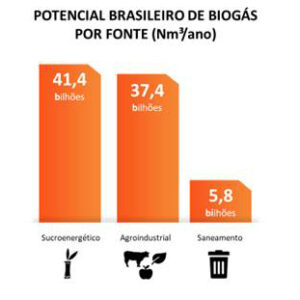
Beyond the urban residential potential for the production of biogas from waste, for reasons of scale and production capacity, the greatest potential production is from industrial waste. The ethanol and agro-industrial sectors have the greatest potential for producing biogas in Brazil.
Our state could be at the forefront of this green energy transition toward biogas since, as fuel, it has a performance similar to Compressed Natural Gas (CNG) and Rio de Janeiro has the country’s largest fleet of CNG-powered vehicles. As well as generating carbon credits and polluting the air less, it is less harmful to the ozone layer, and up to 90% less harmful as a diesel substitute. In the state of Rio, biomethane gas therefore has guaranteed access for use in industry, especially in automobiles, used as fuel in light and heavy vehicles—a growing market.
With the easy availability of raw materials and a growing demand, biogas production systems can be a transformational factor. This also holds true in the realm of education, regarding the correct way of disposing of waste and sewage. This method of producing clean energy makes it possible to obtain financial and environmental benefits, besides making residents the protagonists of the local waste management process.
Making residents understand that their waste can become a renewable energy resource instead of a health problem, could be a public policy used to solve the bottlenecks of lack of urban planning and State neglect, creating a demand for training professionals with new skills aimed at sustainability; professionals trained to work in a new green waste sector, which is still incipient in Brazil.
Looking beyond the waste problem, energy shortages are already a reality and the traditional means for generating energy at scale are obsolete. It is as necessary to diversify energy sources as it is to abandon the outdated and environmentally inefficient techniques for managing waste, aiming at leaving a positive legacy for future generations.
How much biogas could be produced and consumed in Rio de Janeiro’s favelas? How much energy is being wasted in Complexo do Alemão alone with the lack of an environmentally and economically adequate destination for those 80-206 tons of waste produced daily by its residents? How much income could this transformation generate if it were adopted as a public policy for favelas?
Waste is predominantly seen as a problem by society, despite being a source of income for some. But waste can be gold! If transformed into clean energy, waste is gold!
About the author: Cleber Araújo is a resident of Complexo do Alemão and a community communicator.
About the artist: Born and raised in Complexo do Alemão, David Amen is co-founder and communication producer of Instituto Raízes em Movimento, a journalist, a graffiti artist, and an illustrator.
This article is part of a series about energy justice and efficiency in Rio’s favelas.

